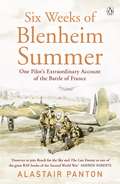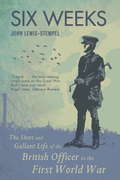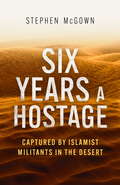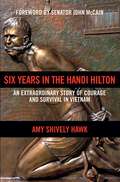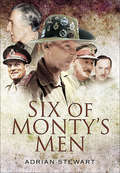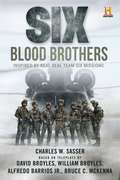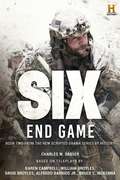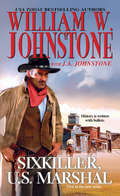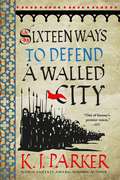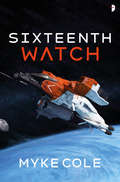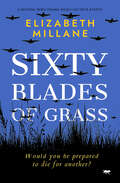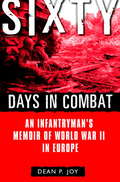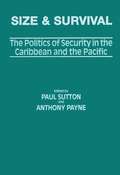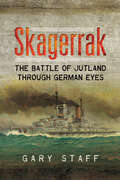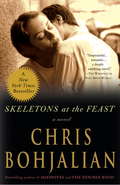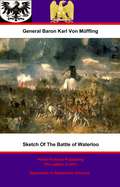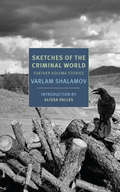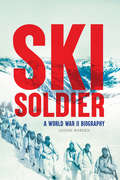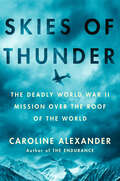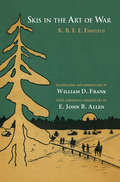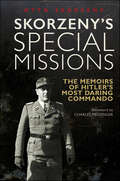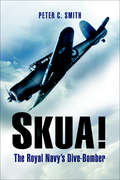- Table View
- List View
Six Weeks of Blenheim Summer: One Pilot’s Extraordinary Account of the Battle of France
by Alastair Panton'DESERVES TO JOIN REACH FOR THE SKY AND THE LAST ENEMY AS ONE OF THE GREAT RAF BOOKS OF THE SECOND WORLD WAR' - ANDREW ROBERTSAs I write, I can clearly recall the stinging heat of aburning Blenheim, smells, tastes, expressions, sounds of voices and, most ofall, fear gripping deep in me.Flying Officer Alastair Panton was just twenty-three when his squadron deployed across the Channel in the defence of France. They were desparate days.Pushed back to the beaches as the German blitzkrieg rolled through the Low Countries and into France, by June 4th 1940 the evacuation ofthe Allies from Dunkirk was complete. A little over two weeks later France surrendered.Flying vital, dangerous, low-level missions throughout the campaign in support of the troops on the ground, Panton's beloved but unarmed Bristol Blenheim was easy meat for the marauding Messerschmitts. At the height of fighting he was losing two of his small squadron's crews to the enemy every day.Discovered in a box by his grandchildren after his death in 2002, Alastair Panton's Six Weeks of Blenheim Summeris a lostclassic. One of the most moving, vivid and powerful accounts of war inthe air ever written. And an unforgettable testament to the courage, stoicism, camaraderie and humanity of Britain's greatest generation.'THE BEST ACCOUNT OF THE CHAOS AND CONFUSION OF WAR OUTSIDE THE PAGES OF EVELYN WAUGH' BORIS JOHNSON'ONE CAN'T HELP FEELING AWE AND REVERENCE. THERE ARE ENOUGHEDVENTURES HERE FOR A LIFETIME'LOUIS DE BERNIERES'SIMPLY WONDERFUL. ONE OF THE BEST ACCOUNTS OF WWii I HAVE EVER READ'JOHN NICHOL
Six Weeks: The Short and Gallant Life of the British Officer in the First World War
by John Lewis-StempelThe extraordinary story of British junior officers in the First World War, who led their men out of the trenches and faced a life expectancy of six weeks.During the Great War, many boys went straight from the classroom to the most dangerous job in the world - that of junior officer on the Western Front. Although desperately aware of how many of their predecessors had fallen before them, nearly all stepped forward, unflinchingly, to do their duty. The average life expectancy of a subaltern in the trenches was a mere six weeks.In this remarkable book, John Lewis-Stempel focuses on the forgotten men who truly won Britain's victory in the First World War - the subalterns, lieutenants and captains of the Army, the leaders in the trenches, the first 'over the top', the last to retreat. Basing his narrative on a huge range of first-person accounts, including the poignant letters and diaries sent home or to their old schools, the author reveals what motivated these boy-men to act in such an extraordinary, heroic way. He describes their brief, brilliant lives in and out of the trenches, the tireless ways they cared for their men, and how they tried to behave with honour in a world where their values and codes were quite literally being shot to pieces.
Six Years a Hostage: Captured by Islamist Militants in the Desert
by Stephen McGownStephen McGown was en route from London to South Africa, on a once-in-a-lifetime trip by motorbike, returning home to Johannesburg. He had reached Timbuktu, in Mali, when he was captured, along with a Dutch and a Swedish national, by Al Qaeda Islamist militants. Steve was taken because he held a British passport. He was subsequently held hostage at various camps in the Sahara Desert in the north-west of Africa for nearly six years before eventually being released.Life as Steve had known it changed in that instant that he was taken at gunpoint. He had nothing to bargain with, and everything to lose. For the next six years, he reluctantly engaged in what he came to call the greatest chess game of his life. Thousands of kilometres to the south, in Johannesburg, the shock of Stephen's capture struck the McGown family and his wife, Cath, with whom he had, until recently, been living in London. They immediately began efforts to secure Steve's release, through diplomatic channels and in every other way they felt might have a chance of seeing Stephen freed. But as the months of captivity became years, Steve was compelled to go to extraordinary lengths to survive. Making it back home alive became his sole aim. To accomplish this, he realised that he would have to do everything he could to raise his status in the eyes of his captors. To this end, he taught himself Arabic and French, and also converted to Islam, accepting a new name, Lot. To this day, Steve retains the unenviable record of being the longest-held, surviving prisoner of Al Qaeda. While he was undoubtedly always Al Qaeda's captive, through the long years he spent in intimate proximity to his captors, Steve got to see the Islamist militants as few other Westerners have ever seen them. Six Years a Hostage is not only a remarkable story of mental strength, physical endurance and the resilience of the human spirit, but also, significantly, a unique and nuanced perspective onone of the world's most feared terrorist groups. Steve did not merely survive his terrible ordeal; he emerged from the desert a changed - stronger, more positive - human being. This is Stephen McGown's remarkable story, as told to Tudor Caradoc-Davies, a freelance writer, editor and author based in Cape Town, South Africa. After seven years spent working for glossy magazines such as Men's Health, GQ, Best Life and Women's Health, he now contributes to a range of publications. He also writes for the (South African) Sunday Times, and Red Bulletin.
Six Years a Hostage: Captured by Islamist Militants in the Desert
by Stephen McGownStephen McGown was en route from London to South Africa, on a once-in-a-lifetime trip by motorbike, returning home to Johannesburg. He had reached Timbuktu, in Mali, when he was captured, along with a Dutch and a Swedish national, by Al Qaeda Islamist militants. Steve was taken because he held a British passport. He was subsequently held hostage at various camps in the Sahara Desert in the north-west of Africa for nearly six years before eventually being released.Life as Steve had known it changed in that instant that he was taken at gunpoint. He had nothing to bargain with, and everything to lose. For the next six years, he reluctantly engaged in what he came to call the greatest chess game of his life. Thousands of kilometres to the south, in Johannesburg, the shock of Stephen's capture struck the McGown family and his wife, Cath, with whom he had, until recently, been living in London. They immediately began efforts to secure Steve's release, through diplomatic channels and in every other way they felt might have a chance of seeing Stephen freed. But as the months of captivity became years, Steve was compelled to go to extraordinary lengths to survive. Making it back home alive became his sole aim. To accomplish this, he realised that he would have to do everything he could to raise his status in the eyes of his captors. To this end, he taught himself Arabic and French, and also converted to Islam, accepting a new name, Lot. To this day, Steve retains the unenviable record of being the longest-held, surviving prisoner of Al Qaeda. While he was undoubtedly always Al Qaeda's captive, through the long years he spent in intimate proximity to his captors, Steve got to see the Islamist militants as few other Westerners have ever seen them. Six Years a Hostage is not only a remarkable story of mental strength, physical endurance and the resilience of the human spirit, but also, significantly, a unique and nuanced perspective onone of the world's most feared terrorist groups. Steve did not merely survive his terrible ordeal; he emerged from the desert a changed - stronger, more positive - human being. This is Stephen McGown's remarkable story, as told to Tudor Caradoc-Davies, a freelance writer, editor and author based in Cape Town, South Africa. After seven years spent working for glossy magazines such as Men's Health, GQ, Best Life and Women's Health, he now contributes to a range of publications. He also writes for the (South African) Sunday Times, and Red Bulletin.
Six Years in the Hanoi Hilton: An Extraordinary Story of Courage and Survival in Vietnam
by John Mccain Amy Shively HawkWith a foreword by Senator John McCain.In 1967, U.S. Air Force fighter pilot James Shively was shot down over North Vietnam. After ejecting from his F-105 Thunderchief aircraft, he landed in a rice paddy and was captured by the North Vietnamese Army. <P><P>For the next six years, Shively endured brutal treatment at the hands of the enemy in Hanoi prison camps. Back home his girlfriend moved on and married another man. Bound in iron stocks at the Hanoi Hilton, unable to get home to his loved ones, Shively contemplated suicide. <P><P>Yet somehow he found hope and the will to survive--and he became determined to help his fellow POWs.In a newspaper interview several years after his release, Shively said, "I had the opportunity to be captured, the opportunity to be interrogated, the opportunity to be tortured and the experience of answering questions under torture. It was an extremely humiliating experience. I felt sorry for myself. But I learned the hard way life isn't fair. Life is only what you make of it." <P><P>Written by Shively's stepdaughter Amy Hawk--whose mother Nancy ultimately reunited with and married Shively in a triumphant love story--and based on extensive audio recordings and Shively's own journals, Six Years in the Hanoi Hilton is a haunting, riveting portrayal of life as an American prisoner of war trapped on the other side of the world.
Six of Monty's Men
by Adrian StewartField Marshal Montgomery showed great skill in choosing his subordinates, whether as staff officers or field commanders. To those he trusted he gave help and guidance as well as a kindness and concern for which he has rarely received credit. In return, they provided services of immense value not only in his own campaigns but in many others throughout the Second World War, to which they brought the knowledge and experience that they had acquired under his leadership.This account follows the careers of six of these subordinates. Harding, the far-sighted staff officer who could take command of a famous armored division with equal ability. Leese, ranked by Montgomery as his finest Corps Commander, but for whom successes and disappointments would be strangely intermingled. De Guingand, the invaluable Chief of Staff whose devotion to duty ruined his health and brought him to verge of a nervous breakdown. Horrocks, who had hated the thought of serving under Montgomery but did so for almost the whole of the war. Richardson, the versatile planner whose varied duties included coordinating the operations of Army and Air Force, anticipating future events, and deceiving the enemy as to his own commanders intentions. Roberts, the brilliant and charismatic armored division commander who became the youngest major general in the British Army.The varied careers and consequent outlooks of these officers serve to throw new light on events that are famous, on incidents that are surprising, unusual or unappreciated, and in particular on the complicated and controversial character of the man whom they all acknowledged to be their leader and their inspiration.
Six: Blood Brothers (History Channel Series: SIX #1)
by Charles W. SasserThe elite Navy unit known as SEAL Team Six is made up of some of the most renown and fearsome warriors of all time, deployed for only the toughest missions in the most dangerous places on Earth. Richard "Rip” Taggart used to lead this unit, until after seeing and experiencing too much on the battlefield he snaps and executes an American in cold blood in Afghanistan. Now, two years later, he has been exiled from his brothers in Six and works for a private security group in Nigeria until he finds himself in the wrong place at the wrong time and is captured by Boko Haram along with a group of Nigerian school girls. <p><p> But the brotherhood of the SEALS runs deep. Once Rip’s unit finds out that he has been taken, they demand to be the ones to bring him back home. But as they mount their rescue operations, they find themselves squaring off against an enigmatic lieutenant of a rising terrorist group, someone who seems to have a particular interest in getting to Rip first.
Six: End Game (History Channel Series: SIX #2)
by Charles W. SasserBased on History’s series SIX, the action-packed sequel to SIX: Blood Brothers.In this thrilling follow-up to SIX: Blood Brothers, the elite unit known as SEAL Team Six arrives at an abandoned village in Nigeria mere minutes too late to rescue former team leader Senior Chief Richard "Rip” Taggart. What they find instead are a group of battle-hardened Chechen fighters and a lot of dead Boko Haram. After a deadly firefight, they’re left only with the knowledge that they are running out of time to find out who now has Rip so they can bring him home.Meanwhile, Rip’s new captor, the enigmatic terrorist lieutenant Michael Nasry, is intent on using the former SEAL for his own ends. And he’ll do whatever it takes to get Rip to cooperate. But this new terrorist threat isn’t the only thing that the warriors of SEAL Team Six have to contend with; each man has his own personal demons, and sometimes the difference between right and wrong isn’t as clear as they might like.Based on the gripping new History Channel series from creators David Broyles, a Special Operations veteran, and William Broyles and inspired by the true stories and events involving SEAL Team Six, SIX: End Game is a front-row seat to the frontline as the team races against time to fulfill one of their most sacred rules: never leave a brother behind.
Sixkiller, U.S. Marshal: Dead Man Walking (Sixkiller, U.S. Marshal #1)
by William W. Johnstone J. A. JohnstoneTHE GREATEST WESTERN WRITERS OF THE 21ST CENTURY In his powerful bestsellers, William W. Johnstone captures the passion and fury of the untamed west. Now, inspired by one of America's most legendary lawmen, he makes history come alive--with a vengeance... THEY CALLED HIM SIXKILLER He was born in the Going Snake District of the Cherokee Nation--and forged a destiny as bold as his name. John Henry Sixkiller was as fearless as they come. He fought in the 2nd Cherokee Mounted Rifles, his father's regiment during the Civil War. Served with the Longhorse Police in Indian territory upholding the law among five tribes in a time of violence and change. But now, Sixkiller faces his greatest challenge yet. As a U.S. marshal, he must take on the most notorious outlaws the west has ever seen. Horse thieves who kill without conscience. Train robbers who terrorize the railways. And one ruthless enemy whose bloody reign of fear would bring Sixkiller to the ultimate showdown. His name means justice. His story is America's.
Sixteen Ways to Defend a Walled City
by K. J. ParkerK. J. Parker's new novel is the remarkable tale of the siege of a walled city, and the even more remarkable man who had to defend it. A siege is approaching, and the city has little time to prepare. The people have no food and no weapons, and the enemy has sworn to slaughter them all. To save the city will take a miracle, but what it has is Orhan. A colonel of engineers, Orhan has far more experience with bridge-building than battles, is a cheat and a liar, and has a serious problem with authority. He is, in other words, perfect for the job. Sixteen Ways To Defend a Walled City is the story of Orhan, son of Siyyah Doctus Felix Praeclarissimus, and his history of the Great Siege, written down so that the deeds and sufferings of great men may never be forgotten.For more from K. J. Parker, check out:The Two of SwordsThe Two of Swords: Volume OneThe Two of Swords Volume TwoThe Two of Swords: Volume ThreeThe Fencer TrilogyColours in the SteelThe Belly of the BowThe Proof HouseThe Scavenger TrilogyShadowPatternMemoryEngineer TrilogyDevices and DesiresEvil for EvilThe EscapementThe CompanyThe Folding KnifeThe HammerSharps
Sixteenth Watch
by Myke ColeThe Coast Guard must prevent the first lunar war in history.A lifelong Search-and-Rescuewoman, Coast Guard Captain Jane Oliver is ready for a peaceful retirement. But when tragedy strikes, Oliver loses her husband and her plans for the future, and finds herself thrust into a role she&’s not prepared for. Suddenly at the helm of the Coast Guard&’s elite SAR-1 lunar unit, Oliver is the only woman who can prevent the first lunar war in history, a conflict that will surely consume not only the moon, but earth as well.
Sixty Blades of Grass: A moving WWII drama based on true events
by Elizabeth MillaneThe bond between a Dutch teenager and her father is tested as the Resistance wages its secret war on the Nazis: &“Darkly lyrical . . . An action filled plot.&” —Mary Glickman, author of By the Rivers of Babylon During the Second World War, Rika, a seventeen-year-old Dutch Resistance fighter, paints in fields overlooking the busy rail yards. Hidden in her artwork is information crucial to the Dutch Underground about the concentration camps and Jewish prisoner transports. But Rika&’s covert activities aren&’t the only thing on her mind. In these uncertain times, even trusting family is risky. She suspects her father of collaborating with the Germans and is determined to uncover the truth. Across town, her German-born father is also living a double life. But his desire to keep his daughter safe proves inadequate when he invites a German colonel into his home with terrible consequences . . . With no one to rely on or turn to, Rika knows her greatest challenge has only just begun as she must fight for her own survival . . . Inspired by the author&’s own family history, this is a riveting, heartrending novel of danger and betrayal that explores what it takes to lay down one&’s life for another in the most harrowing of circumstances.
Sixty Days in Combat
by Dean P. Joy“The infantryman’s war is . . . without the slightest doubt the dirtiest, roughest job of them all. ” He went in as a military history buff, a virgin, and a teetotaler. He came out with a war bride, a taste for German beer, and intimate knowledge of one of the darkest parts of history. His name is Dean Joy, and this was his war. For two months in 1945, Joy endured and survived the everyday deprivations and dangers of being a frontline infantryman. His amazingly detailed memoir, self-illustrated with numerous scenes Joy remembers from his time in Europe, brings back the sights, sounds, and smells of the experience as few books ever have. Here is the story of a young man who dreamed of flying fighter aircraft and instead was chosen to be cannon fodder in France and Germany . . . who witnessed the brutality of Nazis killing Allied medics by using the cross on their helmets as targets . . . and who narrowly escaped being wounded or killed in several “near miss” episodes, the last of which occurred on his last day of combat. Sixty Days in Combatre-creates all the drama of the “dogface’s” fight, a time that changed one young man in a war that changed the world. From the Trade Paperback edition.
Sixty Squadron RAF: A History of the Squadron from Its Formation (Vintage Aviation Library)
by A.J.L. ScottThis candid WWI memoir takes readers inside the cockpit with an RAF officer on the Western Front from the outbreak the Great War until its end in 1918.Louis Arbon Strange was at the Royal Air Force’s Central Flying School when war broke out in 1914. He immediately reported to Royal Flying Corps headquarters and joined No.5 Squadron. Strage remained on active duty throughout the war, serving his country over the Western Front from August of that year until the enemy’s surrender.Strange transferred to No.6 Squadron in 1915 and went on to form and command No.23 Squadron. Due to illness, he did not accompany his Squadron to France, but spent that time training others. He took charge of the Machine-Gun School at Hythe and other schools of aerial gunnery before returning to the Front. There he commanded the 23rd Wing, and finally took command of the 80th Wing from June 1918 until the end of the war. As Strange chronicles his experiences, he provides unique insight into how and why the Allied airmen eventually prevailed.
Size and Survival: The Politics of Security in the Caribbean and the Pacific
by Anthony Payne Paul SuttonThis book provides the first comparative survey of the security problems faced by the small island and enclave developing states of the two major regions in the world characterised by the presence of such states - the Caribbean and the Pacific. It both contributes to the theoretical debate about size and security and offers an up-to-date and comprehensive analysis of the politics of security in these regions.
Sizzling Summer Nights (Made in Montana)
by Debbi RawlinsShe's got this cowboy hot and bothered A week in Montana at the Sundance Ranch is exactly the break Hannah Hastings needs. No dry, dusty Texas. No painful reminders that she's not the son her rancher father wanted. Plus there seems to be no shortage of dead-sexy cowboys in Blackfoot Falls...especially one tall, dark drink of delicious in a Stetson. Hannah was just hoping for a little sexy fun. She never expected Seth Landers to rock her world-or just how much she'd love being in his. But disputes over government land are growing heated in the small Montana town. And Hannah is being drawn into a war she can't win. One where finally gaining her father's approval may mean losing the cowboy she can't help falling for...
Skagerrak: The Battle of Jutland Through German Eyes
by Gary StaffIn January 1916 Vizeadmiral Scheer took command of the High Sea Fleet. This aggressive and pugnacious leader embarked upon a vigorous offensive program which culminated in the greatest clash between dreadnought capital ships the world had seen. Although outnumbered almost two to one, Vizeadmiral Scheer conducted a provocative operation on 31 May 1916. Who would prevail: the massive preponderance of British heavy calibre cannon, or the aggressive tactics of the street fighter Scheer? Manning the ships of both sides were the technically skilled and talented seamen who were prepared to carry out their duties loyally and courageously until the very end. Over 8,500 men perished in less than 10 hours of fighting, a horrendous loss, even by World War One standards. This book gives voice to many of the German Navy participants, from a German perspective, on this tumultuous battle fought over 100 years ago. These men gave their all and are gone now, but not forgotten.
Skeletons at the Feast: A Novel
by Chris BohjalianIn January 1945, in the waning months of World War II, a small group of people begin the longest journey of their lives: an attempt to cross the remnants of the Third Reich to reach the British and American lines. Among the group is 18-year-old Anna Emmerich, the daughter of Prussian aristocrats. There is her lover, Callum Finnella, a young Scottish prisoner of war who has been brought from the stalag to her family's farm as forced labour. And there is the intriguing Wehrmacht corporal whom the pair know as Manfred - who is, in reality, Uri Singer, a Jew from Germany who managed a daring escape from a train bound for Auschwitz. As they work their way west, they encounter a countryside ravaged by war. Their flight will test both Anna's and Callum's love, as well as their friendship with Manfred - assuming any of them even survive. Skilfully capturing the flesh and blood of history, Bohjalian has crafted a rich tapestry that puts a face on one of the 20th century's greatest tragedies - while creating a masterpiece that will, perhaps, haunt readers for generations.
Sketch Of The Battle of Waterloo
by Anon General Freiherr Baron Friedrich Karl Ferdinand Von MüfflingThis ebook is purpose built and is proof-read and re-type set from the original to provide an outstanding experience of reflowing text for an ebook reader. Baron von Müffling was a prominent figure during the campaign of 1815, as a former Quarter-Master General of the Prussian army of Silesia in 1813-1814, he was appointed to be the Prussian Liaison officer with the Anglo-Dutch army under the Duke of Wellington. Privy to all the details current at the allied headquarters, and present on the field of battle Müffling was well placed to write an account of the campaign which was originally in his native German, although short is of enduring interest. It is set with vivid details and unlike staff-officers of later years his place on the battlefield at the Duke's side was one of grave danger as the Anglo-Dutch army struggled to hold on to the ridge at Waterloo. His own action at the battle was indeed decisive, in two incidents, the first in directing the Prussian reinforcements to the right of the hard-pressed allied line, and secondly in bringing up two British cavalry brigades to take part in the final assault on the French lines. He was appointed the Governor of Paris, a particularly tricky job given the recent struggles and the large numbers of armed men roaming the city, which he dispatched with aplomb. Müffling would go on to many important postings in the Prussian army, and even as an international mediator. Author - General Baron Friedrich Karl Ferdinand von Müffling - (1775-1851) Translator - Anon Text taken, whole and complete, from the edition published in 1850, Brussels, by Gérard Original - 102 pages.
Sketches of the Criminal World: Further Kolyma Stories
by Varlam ShalamovThe astonishing follow-up to 2018's Kolyma Stories.In 1936, Varlam Shalamov, a journalist and writer, was arrested for counterrevolutionary activities and sent to the Soviet Gulag. He survived fifteen years in the prison camps and returned from the Far North to write one of the masterpieces of twentieth-century literature, an epic array of short fictional tales reflecting the years he spent in the Gulag. Sketches of the Criminal World is the second of two volumes (the first, Kolyma Stories, was published by NYRB Classics in 2018) that together constitute the first complete English translation of Shalamov&’s stories and the only one to be based on the authorized Russian text. In this second volume, Shalamov sets out to answer the fundamental moral questions that plagued him in the camps where he encountered firsthand the criminal world as a real place, far more evil than Dostoyevsky&’s underground: &“How does someone stop being human?&” and &“How are criminals made?&” By 1972, when he was writing his last stories, the camps were being demolished, the guard towers and barracks razed. &“Did we exist?&” Shalamov asks, then answers without hesitation, &“I reply, &‘We did.&’&”
Ski Soldier: A World War II Biography
by Louise BordenThis true-life adventure story tells the story of Pete Seibert, a ski soldier severely wounded in World War II, who went on to found the Vail Ski Resort in Colorado. <P><P>Ever since he first strapped on his mother’s wooden skis when he was seven, Pete Seibert always loved to ski. At eighteen, Seibert enlisted in the U.S. Army and joined the 10th Mountain Division, soldiers who fought on skis. In the mountains of Italy, Seibert encountered the mental and physical horrors of war. When he was severely wounded and sent home to recover, Seibert worried that he might never ski again. But with perseverance and the help of other 10th Mountain ski soldiers, he took to the slopes and fulfilled his boyhood dream— founding a ski resort in Vail, Colorado. The immediacy of Louise Borden’s vivid text puts readers on the front lines with Seibert and his platoon. <P><P>This dramatic recounting of a World War II experience includes archival photos, as well as commentary on the legacy of the 10th Mountain Division, and a detailed list of sources.
Skies of Thunder: The Deadly World War II Mission Over the Roof of the World
by Caroline AlexanderFrom the New York Times bestselling author, a breathtaking account of combat and survival in one of the most brutally challenging and rarely examined campaigns of World War IIIn April 1942, the Imperial Japanese Army steamrolled through Burma, capturing the only ground route from India to China. Supplies to this critical zone would now have to come from India by air—meaning across the Himalayas, on the most hazardous air route in the world. SKIES OF THUNDER is a story of an epic human endeavor, in which Allied troops faced the monumental challenge of operating from airfields hacked from the jungle, and took on &“the Hump,&” the fearsome mountain barrier that defined the air route.They flew fickle, untested aircraft through monsoons and enemy fire, with inaccurate maps and only primitive navigation technology. The result was a litany of both deadly crashes and astonishing feats of survival. The most chaotic of all the war&’s arenas, the China-Burma-India theater was further confused by the conflicting political interests of Roosevelt, Churchill and their demanding, nominal ally, Chiang Kai-shek.Caroline Alexander, who wrote the defining books on Shackleton&’s Endurance and Bligh's Bounty, is brilliant at probing what it takes to survive extreme circumstances. She has unearthed obscure memoirs and long-ignored records to give us the pilots&’ and soldiers&’ eye views of flying and combat, as well as honest portraits of commanders like the celebrated &“Vinegar Joe&” Stillwell and Claire Lee Chennault. She assesses the real contributions of units like the Flying Tigers, Merrill&’s Marauders, and the British Chindits, who pioneered new and unconventional forms of warfare. Decisions in this theater exposed the fault-lines between the Allies—America and Britain, Britain and India, and ultimately and most fatefully between America and China, as FDR pressed to help the Chinese nationalists in order to forge a bond with China after the war. A masterpiece of modern war history.
Skis in the Art of War (NIU Series in Slavic, East European, and Eurasian Studies)
by K. B. EimeleusK. B. E. E. Eimeleus was ahead of his time with his advocacy of ski training in the Russian armed forces. Employing terminology never before used in Russian to describe movements with which few were familiar, Skis in the Art of War gives a breakdown of the latest techniques at the time from Scandinavia and Finland. Eimeleus's work is an early and brilliant example of knowledge transfer from Scandinavia to Russia within the context of sport.Nearly three decades after he published his book, the Finnish army, employing many of the ideas first proposed by Eimeleus, used mobile ski troops to hold the Soviet Union at bay during the Winter War of 1939–40, and in response, the Soviet government organized a massive ski mobilization effort prior to the German invasion in 1941. The Soviet counteroffensive against Nazi Germany during the winter of 1941–42 owed much of its success to the Red Army ski battalions that had formed as a result of the ski mobilization. In this lucid translation that includes most of the original illustrations, scholar and former biathlon competitor William D. Frank collaborates with E. John B. Allen, known world-wide for his work on ski history.
Skorzeny's Special Missions: The Memoirs of Hitler's Most Daring Commando
by Otto SkorzenyOtto Skorzeny, Germanys top commando in the Second World War, is one of the most famous men in the history of special forces. His extraordinary wartime career was one of high risk and adventure and here he tells the full story. Skorzeny quickly proved his worth in Yugoslavia and then Russia. In 1942 he was awarded the Iron Cross, and in April 1943 he was promoted to captain and named Chief of Germany's Special Troops, Existing or to be Created in the Future. When Mussolini was imprisoned in Italy in 1943, it was Skorzeny who successfully led the daring glider rescue, winning the Knights Cross and promotion as a result. Skorzenys talents were brought into play again when he was sent to Budapest to stop the Hungarian regent Admiral Horthy from signing a peace with Stalin in 1944. Now dubbed the most dangerous man in Europe by the Allies Skorzeny was awarded the German Cross in Gold. A few months later he took a critical role in the Ardennes offensive with a controversial plan to raise a brigade disguised as Americans with captured Sherman tanks. His captured colleagues spread a false rumour that he was planning to assassinate Eisenhower, who was consequently confined to his headquarters for weeks.
Skua!: The Royal Navy's Dive-Bomber
by Peter C. SmithThe Blackburn Skua was the first monoplane to be designed and built for the Royal Navy in the 1930s. As a result of continued debate, it became a compromise between the Navys desire for a carrier-based dive-bomber and RAFs preference for a fighter. Despite being the first to shoot down a Luftwaffe aircraft in World War II, early operations in Norway found the type woefully inadequate as a fighter.As a dive-bomber, the Royal Navy put the design to good use from the outset of WWII. It was involved with the hunt for the Graff Spee, sunk the major warship Koln, suffered with great loss in an attack on the Scharnhorst, helped to keep the German advance at bay during the Dunkirk evacuation and attacked the French rogue battleship Richelieu in the Mediterranean.This book relates how the final design was created, how the dive-bombing technique was developed and perfected by naval pilots and traces the wartime operational career of the type with many first-hand accounts.
